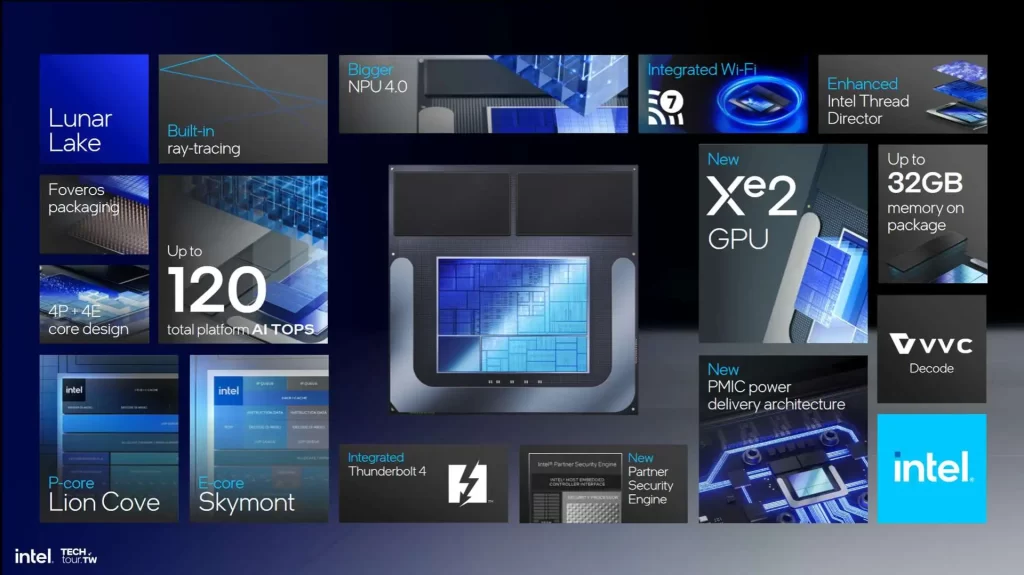At Computex 2024, Intel CEO Pat Gelsinger unveiled the Lunar Lake processor, the next generation of client computing CPUs. This chip boasts significant advancements in architecture, performance, and efficiency, promising a leap forward for laptops and desktops.
Lunar Lake Architecture: A Look Inside
The Lunar Lake System-on-Chip (SoC) boasts a unique design with seven key components. It utilizes Foveros interconnect technology to integrate various tiles, including the compute tile and the Platform Controller Tile, on a single interposer package. This approach, unlike its predecessor Meteor Lake, reduces complexity and latency. The compute tile leverages TSMC’s N3B process for superior performance, while the Platform Controller Tile relies on the TSMC N6 process for efficiency.
One of the highlights of Lunar Lake is its on-package memory, available in 16 GB and 32 GB LPDDR5X configurations. These configurations boast speeds up to an impressive 8533 MT/s, enabling a 16b x4 channel design that significantly reduces power consumption and space requirements.
Cores: Lion Cove and Skymont Take the Stage
Lunar Lake features an 8-core hybrid architecture, combining four high-performance P-Cores (Lion Cove) with four energy-efficient E-Cores (Skymont). A new Thread Director ensures optimal workload allocation between these core types.
The Lion Cove P-Cores are designed for raw power. They deliver a 14% improvement in instructions per clock (IPC) over the previous generation Redwood Cove cores, translating to a 15% increase in performance per watt and a 10% improvement in performance per area. This core boasts features like an 8-wide allocation/rename unit, a 12-wide retirement unit, and a sizeable 576-deep instruction window for efficient task handling.
Skymont E-Cores, on the other hand, prioritize efficiency. Compared to Crestmont E-Cores, Skymont offers a significant 38% and 68% improvement in IPC for integer and floating-point tasks, respectively. This translates to better workload coverage and enhanced AI capabilities. Skymont cores also feature a larger 4 MB shared L2 cache per cluster and support faster L1 to L1 transfers.

Enhanced Power Management and Thread Director
Lunar Lake introduces a refined Thread Director that optimizes P-Core and E-Core utilization. Improved algorithms and finer workload control contribute to better efficiency. Additionally, new OS Containment Zones allow for granular power and performance management by assigning specific tasks to designated core types.
The power management unit within the SoC offers three distinct profiles: Best Efficiency Mode, Balanced Mode, and Performant Mode. These profiles dynamically adjust the SoC’s frequency and scheduling to optimize power consumption, resulting in up to 35% power savings in applications like Microsoft Teams.
A Powerhouse for AI: The NPU 4
Lunar Lake integrates a significantly improved NPU 4, delivering a staggering 48 TOPS (Tera Operations Per Second) for AI processing. This represents a remarkable 4.36x increase in performance compared to the NPU in Meteor Lake. The NPU 4 features 12K MACs (Multiply-Accumulate Units) and 6 Neural Compute Engines, along with a higher clock rate of 1.95 GHz.
Connectivity and Security
Lunar Lake boasts future-proof connectivity with support for Wi-Fi 7 and Thunderbolt 4. It can accommodate up to 3 Thunderbolt 4 ports with the promise of 25% faster speeds when using Thunderbolt 5 SSDs. The integrated Wi-Fi 7 solution offers a smaller design, faster CNVio 3 interface, and improved reliability through Multi-Link Operation (MLO).
Security remains a priority with Intel’s inclusion of various security engines like SSE, GSC, CSME, and PSE, fortifying hardware-based protection.
Availability
Intel anticipates over 80 designs from more than 20 partners for Lunar Lake SoCs. The launch is scheduled for Q3 2024, with broader availability expected in Q4 2024. An AI PC developer kit based on Lunar Lake will also be available, paving the way for future CPUs like Panther Lake.
In conclusion, Lunar Lake represents a significant leap forward in client computing architecture. With its powerful cores, efficient design, and advanced AI capabilities, Lunar Lake promises to deliver exceptional performance and user experiences for laptops and desktops in the near future.






